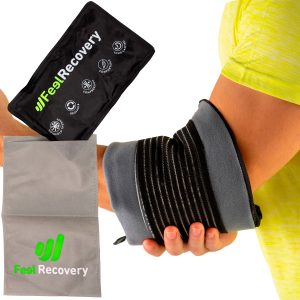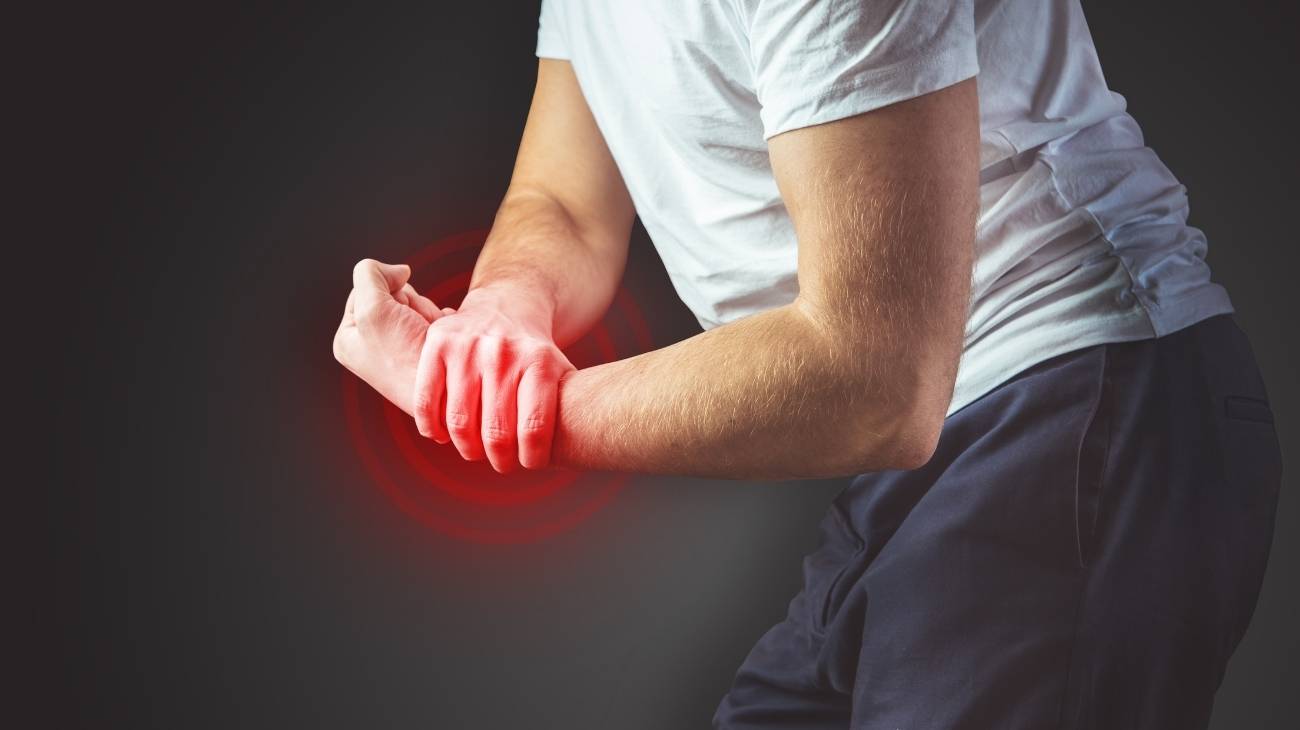- What is olecranon bursitis at the elbow?
- What are the causes and risk factors for elbow bursitis?
- Best products for elbow bursitis
- Main symptoms that warn us that we have bursitis in the elbow joint
- What treatments are available to improve the symptoms of elbow bursitis?
- What are the most effective methods of prevention for elbow bursitis?
Olecranon bursitis tends to heal within a few days, even if it is septic it goes into remission with the right drugs. But for this, it is always necessary to see a doctor so that the ailment does not become serious. For this reason, it is a good idea to know what this disease is and what causes.
In this post, we will show you everything related to the inflammation of the bursa located in the elbow. We will talk, in particular, about the symptoms of this disease and the different treatments that are currently applied to reduce the symptoms. Let's get started.
What is olecranon bursitis at the elbow?
Elbow bursitis is an inflammation of the serosal bursa located between the olecranon and the skin, near which the triceps tendon rests. The pointed end of the bone is protected by the bursa to reduce stress. This synovial bursa is flattened and contains fluid to improve gliding of the joint. However, unlike other bursae in the body, it has little surrounding tissue to contribute to cushioning.
For this reason, olecranon bursitis or "student's elbow" is one of the most common. It begins by containing more fluid than normal and evidencing a large bulge. Depending on the causative agent it may or may not be a septic condition. It is estimated that at least one third of cases in this joint area are infectious. When this occurs it is important to give immediate clinical attention, otherwise the infection may spread to regions such as the arm.
What are the causes and risk factors for elbow bursitis?
Olecranon bursitis often occurs suddenly, making it difficult to determine the causative agent. It is known that people over the age of 40 are more prone to get it, but also those whose profession requires them to make cyclical movements or to lean on their elbows too much.
Associated with this there are other aspects that trigger inflammation, which are:
- Elbow overload: arises from resting the weight of the arms for too long on the olecranial bursa against a hard surface. Injury can also be caused by crawling, climbing or incorrect heavy lifting.
- Recent blows or trauma: Impacts to the initial ulnar region of the elbow are not only very painful, but tend to cause bursitis. Any recent trauma can irritate the synovial bursa and inflame it. For example, it surfaces when the patient falls and the first blow is received by the olecranon region.
- Injuries: Injuries, whether small cuts or deep wounds, also make the synovial bursa prone to this condition. Through this fissure in the skin, it is possible for it to become a point of entry for many micro-organisms, such as bacteria, fungi and viruses.
- Infections: Related to the above, due to injury or other nearby infections, the bursa may contain pathogenic organisms. These micro-organisms multiply rapidly by expelling toxins, which damage the tissues of the bursa.
- Repetitive movements: with each movement, the bursa slides the bones and tendons to withstand the pressure. However, when the same movements are performed repetitively for too long, there is a risk of irritating the bursa tissue.
- Bone spur: Osteophytes or bone spurs are protrusions that protrude into the olecranon complicating normal elbow mobility. If this happens, it is very likely that the bursa will swell and the doctor will resort to intensive treatment or even surgery. This can also be caused by congenital malformations.
- Gout and rheumatoid arthritis: A patient with arthritis or gout can easily develop bursitis. This is because these syndromes attack the soft tissues causing, among other alterations, great inflammation. The signs of this disease are associated with swelling of the synovial bursae.
- Acute bursitis: of course, when the patient has already suffered one or more previous attacks, they are prone to flare-ups. Primarily when the condition has not been treated properly or when the elbow is overloaded, bruised or injured close to recovery time.
- Kidney failure: if the kidneys have lost the ability to properly dispose of blood debris it causes multiple complications in the body. This being so, other associated pathologies could arise such as arthritis or gout. This is when olecranon bursitis suddenly appears.
- Unbalanced diet: when the person does not have a correct diet based on Omega 3 and vitamins, uric acid is likely to generate microcrystals in the joint, thus causing the appearance of bone spurs.
Best products for elbow bursitis
Bestseller
-
2 Elbow Compression Sleeve (Black/Gray)
£17,50 -
2 Elbow Compression Sleeve (Green/Navy)
£17,50 -
2 Elbow Compression Sleeve (Pink/Bordeaux)
£17,50 -
2 Tennis Elbow Brace (Black/Gray)
£12,95 -
2 Tennis Elbow Brace (Green/Navy)
£12,95 -
2 Tennis Elbow Brace (Pink/Bordeaux)
£12,95 -
Acupressure Mat and Pillow (Black/Gray)
£44,95 -
Acupressure Mat and Pillow (Green/Navy)
£44,95 -
Acupressure Mat and Pillow (Pink/Bordeaux)
£44,95
Main symptoms that warn us that we have bursitis in the elbow joint
Because olecranon bursitis can develop gradually, it is likely to go unnoticed at first. The bursa will begin to swell, but there may not be any pain, as it is only after a few days that the symptoms begin to emerge.
It is therefore necessary to be attentive to these symptoms that can warn of the presence of bursitis in the elbow joint:
- Swelling: in the affected area there may be swelling of the tissues near the bursa. This is due to the poor blood supply generated by the autoimmune system; for this reason, the elbow is much larger than normal. This makes normal movement of the joint impossible, while the tension in the area increases when trying to bend or support the elbow.
- Pronounced lumps: a clear evidence of the disease is the appearance of a large lump on the underside of the elbow. If this happens, it has gone from simple swelling to oedema, which is evidence of excessive synovial fluid in the bursa.
- Joint stiffness: factors such as swelling and oedema leave little room for joint mobility and range of motion. This is because the soft tissues are being susceptible to normal movement.
- Pain: the serosal sac is after all soft tissue. When it is irritated, this tissue thickens and stretches, causing pain. In many cases it is mild discomfort rather than severe pain.
- Internal warmth and even fever: A noticeable sign of an infection in the area is that the patient has a high temperature to the touch. This is caused by immune cells acting in the area. If there is a fever, the doctor will perform an aspiration as a means of ruling out the fluid.
- Change in skin texture and colour: as well as internal changes, there are also external changes due to bursitis. It is possible to see sagging, flabbier or smoother skin and also reddened skin. Bruising may also be seen if the bursa begins to store blood.
What treatments are available to improve the symptoms of elbow bursitis?
Similar to bursitis in other areas of the body, the elbow also requires immediate rest. An ultrasound scan is the doctor's most accurate way of detecting its onset, so immobilisation and protection against further irritation is vital to prevent flare-ups.
We will show you below the different types of treatments available to improve the symptoms of elbow bursa inflammation
Alternative and complementary therapies
This type of treatment consists of including techniques that help the disease to go into remission or reduce the symptoms produced by bursitis in the elbow.
See below for a list of the most common alternative and complementary therapies for elbow bursitis:
- Hot and cold therapy: the elbow is exposed to both extremes of heat, i.e. it is placed in warm water and then in lukewarm water. The procedure is repeated to see how the area reacts, taking care not to cause burn injuries. It is also important not to exceed the treatment time of about 20 minutes. The treatment starts with heat, followed by cold and finally heat is used again.
- Compression therapy: common bandages, elastic bandages and elbow braces are often applied by specialists in order to reduce swelling. These are placed completely around the elbow and compress the area, but not too tightly. This reduces the tension in the veins and normalises the vascular walls.
- Thermotherapy: If the elbow bursa has progressed considerably, heat can be applied to reduce pain. Superficial thermotherapy or deep thermotherapy, in which the temperature goes directly to the tissues, can be used. Techniques can vary and may include electric blankets, warm baths, sound waves and lasers.
- Natural remedies using plants: from species such as turmeric, ginger to uncaria tomentosa, or cat's claw, are effective in reducing inflammation and pain. However, as the interaction of their components with drugs can vary, it is best to consult a doctor before applying this method.
- Healthy lifestyle habits: being aware of the joint's need for rest and not exposing the joint is essential. Taking precautions in your daily routine or physical training can also help to avoid overtaxing the muscle-tendon structure of the elbow.
Dietary supplements
After consultation with a nutritionist, he or she may recommend certain vitamin supplements to prevent and improve the condition of the elbow. For example, vitamin A, which acts as an antioxidant to repair tissues, or B complex for tissue health are some frequently prescribed elements.
In addition to this it is possible to incorporate salts and minerals that will help strengthen the affected area to reduce joint stiffness and inflammation of the bursa.
Physiotherapy treatments
This type of therapy consists of using mobility exercises to stretch and lift the joint through repetitive, short-term routines. This strengthens the muscles and prevents atrophy, but without straining the area.
On the other hand, ultrasound can be used by means of mechanical waves that generate heat, which the patient does not perceive and can benefit from all the advantages of thermotherapy. Electrotherapy can also be applied. This consists of achieving an electrochemical effect by means of electronic currents to alleviate the sensation of pain, produce a sedative effect and reduce deep swelling.
Medicines
The most commonly used drugs in this type of therapy are the NSAID anti-inflammatory drugs, which do not contain steroids. This group includes ibuprofen, aspirin and ketoprofen. In addition, antibiotics can be used to eradicate the infection and, in some cases, anti-inflammatory corticosteroids are used by injection.
It should be borne in mind that this therapy must be prescribed and directed by a doctor and should never be self-medicated, as this could have serious consequences for the patient.
Surgery and fluid removal
It should not be forgotten that bursitis is excess fluid in the bursa located under the olecranon, so in more advanced cases of the disease it is possible to insert a needle directly into the bursa to drain the fluid.
Bursectomy is also a technique used to remove excess bone that prevents proper recovery from the disease. This surgical procedure is performed under local anaesthesia.
What are the most effective methods of prevention for elbow bursitis?
The joints in the extremities of the arms are used on a daily basis so the elbows must be cared for. Therefore, before the disease appears, it is good to take preventive actions, which are listed below:
- Limb warm-ups: preparing the joint area for exercise for about 15 minutes never fails. It is a safe method of preventing injury, trauma or inflammation such as bursitis. Each sport or work activity requires different warm-ups, so it is advisable to visit your doctor to obtain the best advice for each case.
- Avoid activities that are too demanding: if your work involves tasks that place excessive demands on the joints, or if you practice a sport that requires a great effort from the elbow, it is necessary to take time to rest and protect the joint with bandages or other compression elements. If you do not need to work or practice demanding exercises, it is preferable to avoid them.
- Do not use your elbow as a point of support: it is best to forget the habit of resting your elbow on rough and hard surfaces, especially if you tend to spend a lot of time in the same position. Therefore, changing the position from time to time avoids overloading the bursae.
- Never do forced rotations: a sudden rotational movement can trigger the inflammatory condition. This is further aggravated if the joint has not been warmed up beforehand. Therefore, you should take care not to rotate the elbow quickly by exerting too much force on the joint.
- Eat a healthy diet: an unhealthy diet increases the uric acid levels that lead to gout. It is better to add foods rich in fibre, antioxidants and nutrients.
- Avoid prolonged movements: throwing and hitting over and over again wears down the strength of the bursae. Periods of rest are important for the tissue to oxygenate and rest.
- Don't lift heavy things: this will prevent strain on the bursa, muscles and tendons of the elbow. So the risk of inflammation in the bursa will be minimised.
References
- Blackwell, J. R., Hay, B. A., Bolt, A. M., & Hay, S. M. (2014). Olecranon bursitis: a systematic overview. Shoulder & Elbow, 6(3), 182-190. https://journals.sagepub.com/doi/abs/10.1177/1758573214532787
- Floemer, F., Morrison, W. B., Bongartz, G., & Ledermann, H. P. (2004). MRI characteristics of olecranon bursitis. American Journal of Roentgenology, 183(1), 29-34. https://citeseerx.ist.psu.edu/document?repid=rep1&type=pdf&doi=e7cce321d245997111e71d15a926e567c5f1a195
- Del Buono, A., Franceschi, F., Palumbo, A., Denaro, V., & Maffulli, N. (2012). Diagnosis and management of olecranon bursitis. the surgeon, 10(5), 297-300. https://www.sciencedirect.com/science/article/abs/pii/S1479666X12000108
- Degreef, I., & De Smet, L. (2006). Complications following resection of the olecranon bursa. Acta orthopaedica belgica, 72(4), 400. http://www.actaorthopaedica.be/assets/1005/04-Degreef_et_al.pdf
- Nirschl, R. P. (1984). Arm Care. Relief and Prevention for Shoulder Tendonitis, Tennis Elbow, Bursitis and Wrist Sprain in Athletics and Other Activities. Medical Sports, Inc., Publications Division, PO Box 7187, Arlington, VA 22207. https://eric.ed.gov/?id=ED261991
- McAfee, J. H., & Smith, D. L. (1988). Olecranon and prepatellar bursitis. Diagnosis and treatment. Western Journal of Medicine, 149(5), 607. https://www.ncbi.nlm.nih.gov/pmc/articles/PMC1026560/
- Reilly, D., & Kamineni, S. (2016). Olecranon bursitis. Journal of shoulder and elbow surgery, 25(1), 158-167. https://www.sciencedirect.com/science/article/abs/pii/S1058274615004693
- Khodaee, M. (2017). Common superficial bursitis. American family physician, 95(4), 224-231. https://www.aafp.org/pubs/afp/issues/2017/0215/p224.html
- Rasmussen, K. J. E., & Fanø, N. (1985). Trochanteric bursitis: treatment by corticosteroid injection. Scandinavian journal of rheumatology, 14(4), 417-420. https://www.tandfonline.com/doi/abs/10.3109/03009748509102047
- Sayegh, E. T., & Strauch, R. J. (2014). Treatment of olecranon bursitis: a systematic review. Archives of orthopaedic and trauma surgery, 134, 1517-1536. https://link.springer.com/article/10.1007/s00402-014-2088-3


























